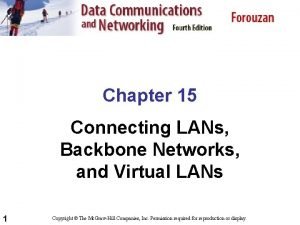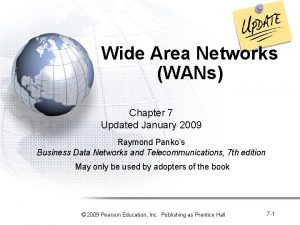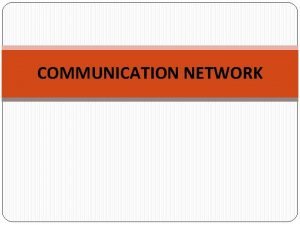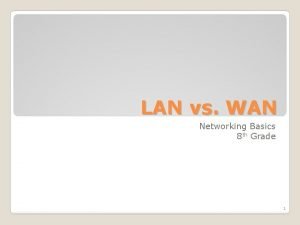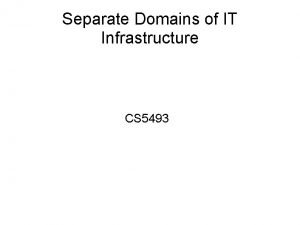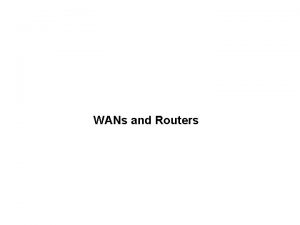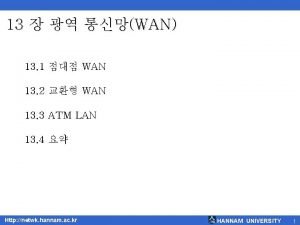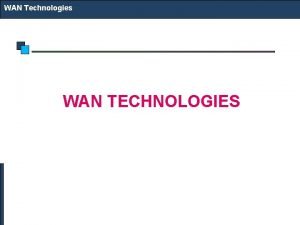LANs and WANs WAN LAN WAN INTERN ETVs









- Slides: 9

LANs and WANs WAN LAN WAN INTERN ETVs LAN Internet and Intranet Department Of Commerce (Banking and Insurance) MANAGEMENT BANKING TECHNOLOGY Unit-I LANs and WANs Internet and Intranet E-Mail Presented by Dr. R. RAJESH Associate Professor and Head

Types of Networks: LANs and Networks are divided into two WANs types, a LAN (Local Area Network) or a The Internet can be thought of as a bunch of LANs interconnected by WANs. An average packet will run across a company’s local Ethernet (LAN), up an ISDN or leased line or PPP link (WAN) to an Internet Service Provider. The ISP has Ethernet too (LAN) that transports the packet to the right router for delivery to a cross-country provider (WAN). The packet begins bouncing from one LAN site to another over WAN links. LANs and WANs WAN LAN WAN INTERN ETVs LAN Internet and Intranet WAN (Wide Area Network), which are generic terms referring to two important basic types of networks.

Local Area Networks (LAN) LANs and WANs Advantages of LANs: q Hardware such as printers can be shared so individual workstations do not need their own printer. When they print, the data is stored in a queue on a server. The data is then passed to the printer. q All the users work can be stored in a central place (the dedicated file server). q Software can be shared, software packages are stored on the server and downloaded to workstations as requested. q Data can be shared because database files stored in the server are available to users around the network; data from CD-ROMs can also be shared across the network. q Central back-up can take place automatically at regular intervals. q Messages can be sent to people working at other computers on the network which can save time and paper. q It is possible to set up a local intranet. The web pages of information can be accessed only over the LAN. An intranet is free because it does not involve phone links. q There is control over users’ access rights to programs and data. LAN WAN INTERN ETVs LAN Internet and Intranet LAN is widely used to share resources and exchange information by connecting personal computers and workstations in company office and factories. A LAN is a network that is limited to an area such as a building or school. In a LAN, computers and hardware such as printers can be connected by cable (copper wiring), fibre optic cabling (glass fibres) or using a wireless (radio waves) connection.

LANs and WANs Disadvantages of LANs: v Printing can be slow. Where a lot of workstations are served by only one or two printers, long print queues may develop. v A virus can spread more easily. If a virus gets into one computer, it is likely to spread quickly across the network because it will get into the central backing store. v As data is shared there is a greater need for security. Users of the network have to have authentication techniques such as user ids and passwords. Unique user ID’s control access to the files and settings on the network while passwords prevent unauthorised users from logging onto the network. Data may also have to be encrypted so that it is meaningless if intercepted. v If the server fails, all the workstations are affected. Work stored on shared hard disk drives will not be accessible and it will not be possible to use network printers either. v The cost of installing the equipment is greater. Cabling can be expensive to buy and to install. v Damage to cables can isolate computers. Some sections of the network can become isolated and will not be able to communicate with the rest of the network. v Because networks can be complicated to maintain, a network manager may be need to be employed to run the system. LAN WAN INTERN ETVs LAN Internet and Intranet Local Area Networks (LAN)

Wide Area Network (WAN) Disadvantages of WANs: v Again these are similar to those of LAN’s except that issues such as security become even more important as potential hackers could break into a computer system from anywhere in the world rather than having to physically be in a building. v Encryption of secure data such as financial transactions is necessary because it is even easier to intercept data. LANs and WANs WAN Advantages of WANs: q These are similar to those of LAN’s except the scale of sharing etc. becomes far greater and can be world-wide. WAN LAN The Internet is a worldwide WAN and a LAN can be connected to it using a router. INTERN ETVs LAN Internet and Intranet A Wide Area Network (WAN) is not confined to one building. The computers and terminals forming part of the network can be spread around the world. External communication links such as satellites, microwaves, and telecommunication links and optical fibre will be used to connect the parts of a WAN. The connection must normally be paid for because the links are external.

dense installation Current Speed: Faster Common uses: File sharing length of long-haul lines Comparatively Slower Email and file transfer (including Web) Common Cable disruption by users. Cable disruption by external problems: entities Conceptually: A bunch of lines linking cities users together LANs and WANs Cost center: WAN LAN Most commonly: Advantage: Local Area Networks Wide Area Networks (LANs) (WANs) Ethernet, Token Ring, Leased lines, serial links, ISDN, FDDI X. 25 Speed Distance LAN Vs WAN INTERN ET Internet and Intranet LAN/WAN Comparison

LANs and WANs Internet is accessible to every user all over the world. WAN A special computer DNS (Domain Name Server) is used to provide a name to the IP Address so that the user can locate a computer by a name. For example, a DNS server will resolve a name https: //www. google. com to a particular IP address to uniquely identify the computer on which this website is hosted. WAN LAN Internet It is a worldwide/global system of interconnected computer networks. It uses the standard Internet Protocol (TCP/IP). Every computer in Internet is identified by a unique IP address. IP Address is a unique set of numbers (such as 110. 22. 33. 114) which identifies a computer’s location. INTERN ETVs LAN Internet and Intranet Internet

LANs and WANs WAN LAN Each computer in Intranet is also identified by an IP Address which is unique among the computers in that Intranet. WAN Intranet is the system in which multiple PCs are connected to each other. PCs in intranet are not available to the world outside the intranet. Usually each organization has its own Intranet network and members/employees of that organization can access the computers in their intranet. INTRAN ETVs LAN Internet and Intranet

Similarities and Differences between Internet and Intranet Similarities between Internet and Intranet Ø Intranet uses the internet protocols such as TCP/IP and FTP. ü Internet provides a wider and better access to websites to a large population, whereas Intranet is restricted. ü Internet is not as safe as Intranet can be safely privatized as per the need. LANs and WANs WAN LAN WAN Differences between Internet and Intranet ü Internet is general to PCs all over the world whereas Intranet is specific to few PCs. Internet and Intranet Ø In Intranet, own instant messengers can be used as similar to yahoo messenger/gtalk over the internet. INTRAN ETVs LAN Ø Intranet sites are accessible via the web browser in a similar way as websites in the internet. However, only members of Intranet network can access intranet hosted sites.
